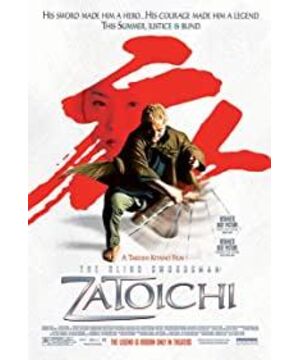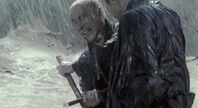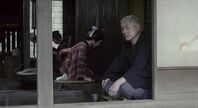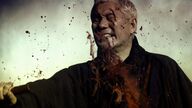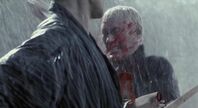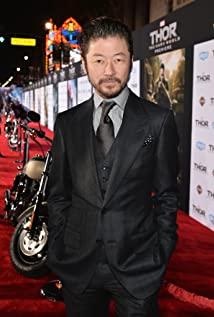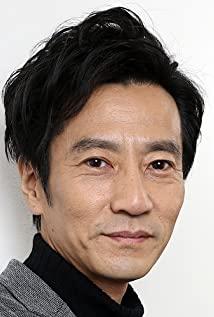In those summers, from the history of the Three Kingdoms to Taiko’s resolution, as far as the knowledge at that time is concerned, Japanese history and culture is really an undeveloped place, so I suddenly indulged in it, eagerly absorbed knowledge about the game, and searched. With all the historical materials that can be found, Mr. R also deliberately created a novel with samurai as the theme (unfortunately, it was abandoned halfway and lost), so the age of a samurai appeared in the years of growth. So one day Mr. R told me that this film is very good, so he forged an indissoluble bond with Zatoichi.
At first, I thought that Zuotou City was just a place name, just like Zengtou City in "Water Margin", but it turned out to be a personal name. However, the ignorance of the Zato market has been retained until now. Would you like me to introduce the next Zato market? The only thing I can say is Takeshi Kitano. I haven't seen any of Katshintaro's series before, but according to the stereotype, it should be a classic samurai movie. As for the work of Takeshi Kitano, people who don't like it say it's nonsense, and those who like it are innovations in inheritance, but it really looks different in the samurai movies I have watched.
The rough titles and subtitles of the title and the appearance of the characters are like watching a western movie. It is rough and direct. Zatoichi's fierce and quick attack has a violent beauty (unfortunately, the sense of special effects is a bit obvious), and the knife accidentally hurts oneself. The scene also made people laugh, (Take Kitano's spoof and joke?) Suddenly attracted the attention of the audience, looking forward to the development of the plot and more exciting fights. As a result, the plot of the movie began to enter the formal stage, and all walks of life also appeared on the stage.
Compared with Chinese martial arts movies, Japanese fights do not involve too much entanglement, nor do they have a variety of moves. They are often simple and clear, and the winner is determined instantly. This is related to the profound meaning of Japanese kendo pursuit of one blow. Therefore, the design and use of the samurai sword are compatible with the secrets of Japanese swordsmanship, which is the pursuit of one strike. However, Chinese martial arts movies pay more attention to action. Whether it’s a quick glance or flying over the wall, the climax of the movie is often a kung fu duel that lasts a few minutes or longer. The previous plots are used as a foundation and foil for the duel. So since the confrontation of Japanese samurai movies is only a few seconds (there are exceptions, the gang fight scenes in samurai movies can also be as long as a few minutes, such as "Slicing the Belly"), then you can't just rely on the few seconds of the confrontation to let the audience enjoy the pleasure of the movie. , So the compactness of the plot and the arrangement of the number of fighting scenes are the key points.
Kitano Takeshi’s fight scenes are very powerful, although the special effects are more obvious, it does not affect the audience's appreciation. Fighting in the rain for a period, the action is slightly slowed down, creating a poetic rhythm, the cooperation of the action and the raindrops makes the whole scene violent with gorgeousness; and the one in the courtyard house, the rhythm is fast, the blood rushes, and the slightly darker The tones are full of unrestrained violence, and every time Zato City swings a knife, he can feel the bloodthirsty rage (maybe Kitano Takeshi’s cool appearance is also to show violent unrestrained, compared with Asano Tadanobu’s showdown. It seems to rely more on technology rather than unrestrained instinctive killing in the style of the city); and the final confrontation between Takeno Kitano and Tadanobu Asano is only a few seconds, but through the stalemate and inner activities between the protagonists, to create a tense atmosphere, although the confrontation Short, but let the previous tension be completely released (such as the three-person showdown in "The Good, the Bad and the Ugly"). Therefore, the different styles of fighting in the film seem to be easy and wonderful, and I have watched the fighting clips countless times.
But apart from the action, the plot is not compact enough. The next stage of the plot is completely brought out through the three casino scenes. The use of space and the mastery of the rhythm are a bit procrastinated, so Kitano chose to take the life of the peasant and Tadanobu Asano's The spur line is filled in and stuffed into the entire frame. Although the details of the peasants' lives alleviated the inability of the plot to advance to a certain extent, in general, the narrative of the story is still insufficient. But when it comes to farmers, the tap dance at the end of the film blinds the audience, which makes one can't help but think of the ending of "Seven Samurai", but Kitano just used the form to harmonize the atmosphere, instead of creating irony. The chaotic entry of this style once again ridiculed the traditional style of samurai films, but it gave the film an alternative and diversified modern style. Perhaps it was just a spoof by Kitano Takeshi, or it added alternative vitality to make up for the overall mediocrity of the film. , But the effect is really good, there is an alternative taste of Pop-ism splicing (Almodova's use of style collage is the best, so the film has created a unique absurdity in reason). From this point of view, perhaps Kitano's acting style desperately acting cool in the whole film is not only to take care of facial paralysis, but also for the consideration of style collage. Anyway, he is very useful anyway.
The side effect after watching the movie is that I have studied the samurai sword for a long time, and my enthusiasm has not diminished.
View more about The Blind Swordsman: Zatoichi reviews


